Check out the article written by Kachemak Bay Birder George Matz on “Why Are Shorebirds Special”. We all know the answer.
http://homernews.com/point-view/2018-05-23/why-are-shorebirds-special
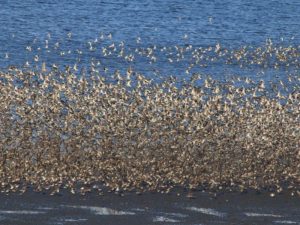
Check out the article written by Kachemak Bay Birder George Matz on “Why Are Shorebirds Special”. We all know the answer.
http://homernews.com/point-view/2018-05-23/why-are-shorebirds-special

(Zonotrichia atricapilla)
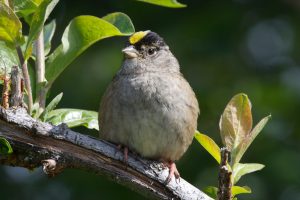
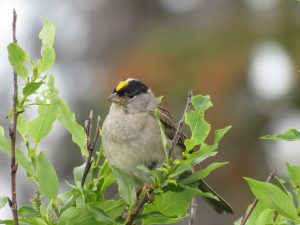
General Information: The Golden-crowned Sparrow is a common, large sparrow in the family Passerellidae, genus Zonotrichia. This genus consists of four species: Golden-crowned, White-crowned, White-throated, and Harris’s Sparrows. Both the Golden-crowned and White-crowned species are commonly found in the Homer area.
Range: Birders in Homer are fortunate to have this species as a summer visitor since it is not wide-spread – restricted in its range. Its breeding season range is limited to western Canada and Alaska. Migration takes it as far south as Baja California, spending much of its time on the western coast in weedy or brushy areas. A few birds will remain year-round in the Homer area – at lower elevations.
The Golden-crowned Sparrow is a rare visitor to the Interior West U.S. and casual in the Eastern United States.

Source: https://www.allaboutbirds.org/guide/Golden-crowned_Sparrow/maps-range
Bird Biology:
Characteristics: Breeding adults have a distinctive, yellow fore-crown, with black stripes on each side of the crown. Besides the distinctive yellow crown, other field marks include a bi-colored bill, a gray-brown breast, with no spotting, and a pale brown rump.
Immature Golden-crowned Sparrows are similar to immature White-crowned Sparrows. One of the key distinguishing marks between the two immature sparrow species is the color of the bill. The White-crowned Sparrow has a pinkish, orange bill while the Golden-crowned Sparrow has the bi-colored bill.
Preferred Habitat: Low shrubs, dense vegetation.
Breeding Season: Pairs are monogamous during the breeding season.
Nest: Golden-crowned Sparrow build a thick cup nest generally on the ground at the base of a small, dense shrub or in a bank with overhanging plants. The nests are composed of small twigs, bark, ferns, dry grasses, and dead leaves. They will line the nest with fine grasses, hair, and feathers.
Eggs and Incubation: Three-five eggs are typically laid. The female incubates the eggs 11-13 days. When hatched, the chicks are atricial (unable to eat on their own) and naked.
Fledging: Both parents feed the young. Chicks quickly grow their downy feathers and leave the nest within 9 days, and are able to fly short distances 4 days later, thereby becoming independent.
Food Preferences: The Golden-crowned Sparrow are omnivores – they eat both plants and animals. More is known about their winter diet, than their summer diet. In the winter they eat a variety of food types, including seeds (geranium, pigweed, starwort, dock, grasses, sumac, nightshade, knotweed), fruits (apples, grapes, elderberry, olive), grains (oats, wheat, barley, corn), buds, flowers, and plant sprouts. They will also eat insects (ants, wasps, bees, moths, butterflies, beetles, terminates, and flies). In the summer it is believed they eat insects, fruit, seeds, and spiders.
Feeding Methodology: The Golden-crowned Sparrows is a ground forager, preferring to feed close to cover, gleaning for seeds or scratching leaf litter to uncover morsels. They often feed alone or in pairs.
While they are less aggressive when feeding, they do defend breeding territories (approximately 2.5 acres in size).
Migration: This bird’s entire population takes the same migration route each year – along the West Coast from its wintering grounds (anywhere northern Baja California to southern British Columbia, Canada) to its breeding grounds (in Alaska and Northwestern Canada) and back. Spring migration is April and May, while fall migration begins in late August.
Wintering Golden-crowned Sparrows can usually be found in flocks with White-crowned Sparrows. Both species winter in small numbers in the Homer area.
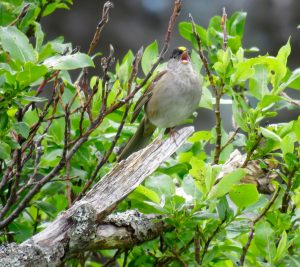
Vocalizations:
Song: A series of high clear whistles with a mnemonic of “I see you” or “Come see me” or even “Oh Pretty Bird”. At least that is what I hear when they sing. Try out a version that works for you.
Call: A clear “Tew”.
Flight Call: A high “seep”.
Threats: Feral and outdoor domestic cats. Other birds, such as corvids (Raven, crows, magpies, jays) will predate the eggs and chicks of a Golden-crowned Sparrow.
Fun Facts:
Conservation Status: The global population is estimated at 4.0 million species. The species is not on the U.S. State of the Birds Watch List nor Audubon Alaska’s Watch List. The International Union for Conservation of Nature lists the Golden-crowned Sparrow as a species of Least Concern; its population trend increasing. However, this species has had little study and it is not known how it responds to human influences. The effects of climate change on this species is also not known. With a restricted range, the bird may be vulnerable to habitat change.
Other Sparrow Species in Alaska: Common sparrow species found around the Homer area include: White-crowned Sparrow, Savannah Sparrow, and Lincoln’s Sparrow. The White-throated Sparrow, Chipping Sparrow, and American Tree Sparrow are also occasionally found in our area. The American Tree Sparrow is a common species elsewhere in Alaska, unfortunately outside of the Homer area.
Sources of Information:
Baicich, Paul J. and Harrison, Colin J.O. 1997. Nests, Eggs, and Nestlings of North American Birds, 2nd Edition. Princeton Field Guides.
Cornell Lab of Ornithology. All About Birds – Golden-crowned Sparrow. https://www.allaboutbirds.org/guide/Golden-crowned_Sparrow/overview Downloaded on 6 April 2018.
Dunne, Pete. 2006. Pete Dunne’s Essential Field Guide Companion: Comprehensive Resource for Identifying North American Birds. Houghton Mifflin Company.
International Union for Conservation of Nature. The IUCN Red List of Threatened Species. Version 2017-3. <www.iucnredlist.org>. Downloaded on 06 April 2018.
Lucas DeCicco/Macaulay Library at the Cornell Lab
National Audubon Society. Edited by Elphick, C., Dunning, Jr. J.B., and Sibley, D.A. 2001. The Sibley Guide to Bird Life and Behavior. 2001. Alfred A. Knopf Inc.
Sibley, David Allen. 2003. The Sibley Field Guide to Birds of Western North America. Andrew Stewart Publishing Inc.
Todd, Frank S. 1994. 10,001 Titillating Tidbits of Avian Trivia. Ibis Publishing Company.
Warnock, N. 2017. The Alaska WatchList 2017. Audubon Alaska, Anchorage, AK 99501.
It’s A Great Day to Bird
Landon Bunting and Nolan Bunting talk about the shorebird “Wilson’s Snipe” – the Kachemak Bay Birders “BIRD OF THE MONTH” for May, 2018. For more information on the Wilson’s Snipe, check out our “Bird of the Month” page.
Bird Rhythms originally aired on KBBI on May 28, 2018 as part of the Kachemak Science monthly program.
(Gallinago delicate)
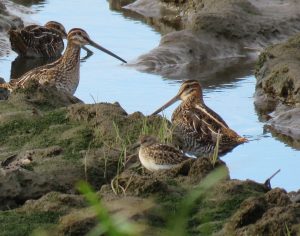
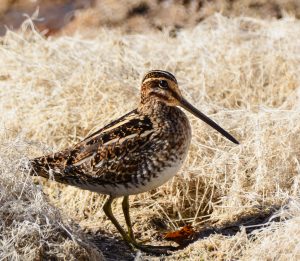
General Information: The Wilson’s Snipe, a member of the Cholopacidae family, genus Gallinago, a common and widespread shorebird species, is not typically found along shorelines, but rather wetlands. The Wilson’s Snipe has a global breeding population estimated at 2 million birds.
These birds are generally not seen, since they camouflage so well, until flushed when they explode into zigzag flight, uttering their flight call.
Wilson’s Snipe is named for the ornithologist and author Alexander Wilson, who was born in Scotland in 1766, and later emigrated to America. There are four other birds named for him: Wilson’s Warbler, Wilson’s Phalarope, Wilson’s Plover, and Wilson’s Storm-Petrel.
Range: The Wilson’s Snipe can be found throughout North America, breeding in several northern Lower 48 states, and in Canada and Alaska. The bird is a year-round resident of several western states, and parts of Alaska, including Kodiak Island.

Source: https://www.allaboutbirds.org/guide/Wilsons_Snipe/maps-range
Bird Biology:
Characteristics: This secretive, stocky shorebird is dark brownish overall, with bold cream-colored stripes on its neck and head. The stockiness is due to extra-large pectoral muscles. Snipe weigh in at 3.7 ounces (yes, about 1/3 of a pound), and are 10-11 inches in length.
Snipes may form loose groups of up to 10, but are generally a solitary bird.
Preferred Habitat: Although a “shorebird”, these birds prefers moist habitat, such as wetlands (marshes, bogs, and willow/alder swamps) during the breeding season. During migration and on the wintering grounds they prefer damp areas with vegetative cover, such as wet fields, marshes, and ditches.
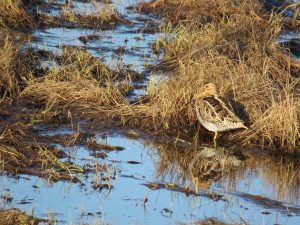
Breeding Season: Breeding begins in mid-May, which is a great time to hear and, with luck, see a male Wilson’s Snipe performing his aerial display where they zigzag across the sky at speeds of up to 60 miles per hour. Listen for the distinctive winnowing display sound as you try to locate the bird high above.
Nesting: Wilson’s Snipe are ground nesters. The female builds the nest – a shallow scrape in moist soil. She weaves a lining of coarse grasses, building a nest up to 3 inches deep, and 7 inches across. Once that is accomplished, she then adds finer grasses inside; and takes a few more grasses or sedges (sedges have edges) from the edge of the nest for placement in the nest.
Eggs and Incubation: The female has full incubation responsibility, laying four eggs, which she incubated for 18-20 days. Hatching is asynchronistic, meaning eggs hatch at different times. Only one brood per season is common, and then re-nesting may occur.
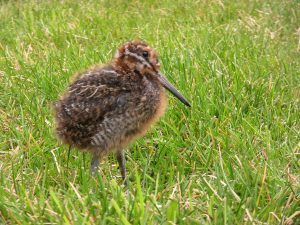
Fledging: The young snipes are able to fly within 19-20 days of hatching. Once the chicks fledge, the parents separate with the male taking and caring for the two oldest chicks, and the female the two youngest chicks.
Food Preferences: The Wilson’s Snipe by probing for aquatic invertebrates – primarily insect larvae, but also crustaceans, earthworms, and mollusks.
Feeding Methodology: Wilson’s Snipe stick their long beaks deep into the soil or shallow water as they probe for their food – sewing machine style. They may occasionally use foot stomping or bouncing to locate – ‘scare up’ – prey. Snipe are active feeders day and night, so your chances are good to see one if you look closely (they camouflage well). The bill has a flexible tip allowing the bird to open it to grasp food while the base of the bill remains closed. This allows them to ‘slurp up’ prey without removing their bills from the soil.
Roosting: They are often spotted standing on fence posts and in trees or dense vegetation.
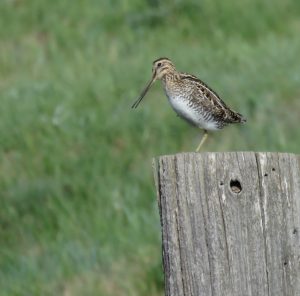
Migration: Wilson’s Snipe generally arrive in the Homer area in late April or early May. They are readily identified by their spiraling flight display and the winnowing sounds that result from air moving through their tail feathers.
For those birds that migrate, spring migration is from late February through late May. Fall migration is from mid-July to December. The snipe migrate mostly at night.
In some parts of the U.S., Wilson’s Snipe are year-round residents – aren’t those birders lucky. The bird winters in the United States, Central America, and as far south as Venezuela.
Vocalizations: Flight call is a harsh “scrape”. The perch display song is a loud, repeating “TIKa” or “TUKa” sound. And of course, the “hu-hu-hu-hu-hu” winnowing sound is made during flight display, when the air moves through the bird’s tail feathers.
The Cornell Lab of Ornthology has gracious provided us with the call and flight display sounds of the Wilson’s Snipe.
Call
Flight Display
Threats: Most states do allow hunting of snipe. Hunters consider them a challenge with their explosive, surprising, flushing from their concealment. Between 2006 and 2010, approximately 105,000 snipe were taken annually by U.S. and Canadian hunters. This number is believed to be considerably lower than the number of snipe hunted for “sport” during the mid-twentieth century.
Other threats include loss of wetland habitat due to conversion and draining; and collisions with radio, TV, and cell towers, powerlines, buildings (glass), and vehicles.
Fun Facts:
Conservation Status: The International Union for Conservation of Nature (IUCN) have identified the Wilson’s Snipe as a species of Least Concern on their Red List of Threatened Species. However, they also note that the population trend for the species is decreasing. Wilson’s Snipe do not appear on the Alaska Audubon’s Watchlist.
Snipe Species in Alaska: Occasionally the Common Snipe or Jack Snipe have been found in Alaska. Such sightings are rare.
Sources of Information:
American Bird Conservancy. Bird of the Week. https://abcbirds.salsalabs.org/birdoftheweekwilsonssnipe/index.html?wvpId=2c437645-6800-11e7-a58d-1254aa67e287. Downloaded on 15 April 2018.
Cornell Lab of Ornithology – All About Birds. https://www.allaboutbirds.org/guide/Wilsons_Snipe/id. Downloaded on 15 March 2018.
International Union for Conservation Nature. The IUCN Red List of Threatened Species. Version 2017-3. <www.iucnredlist.org>. Downloaded on 15 March 2018.
North American Bird Conservation Initiative. 2016. The State of North America’s Birds 2016. Species Assessment Summary and Watch List. http://www.stateofthebirds.org/2016/resources/species-assessments/
O’Brien, M., Crossley, R., and Karlson, K. 2006. The Shorebird Guide. Houghton Mifflin Company.
Sibley, David Allen. 2003. The Sibley Field Guide to Birds of Western North America. Andrew Stewart Publishing Inc.
Warnock, N. 2017. The Alaska WatchList 2017. Audubon Alaska, Anchorage, AK 99501.
Wil Hershberger//Macaulay Library at the Cornell Lab
William W. H. Gunn//Macaulay Library at the Cornell Lab
(Antigone canadensis canadensis)
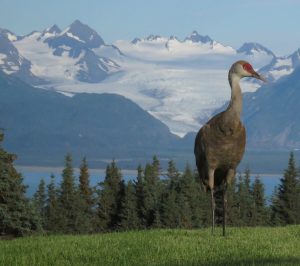
Sandhill Crane (Photo by Nina Faust)
General Information
There are 15 crane species in the world. Two of those species – the Sandhill Crane and Whooping Crane – breed in the United States. There are six subspecies of the Sandhill Crane: Greater, Lesser, Canadian, Mississippi, Florida, and Cuba. Our Homer Cranes are of the Lesser Sandhill Crane subspecies.
The Sandhill Crane is a member of the Gruidae family; and was formerly in the genus Grus, but was recently reclassified to the Antigone genus. The species remains the canadensis.
Range: There are two flyways for the Lesser Sandhill Crane: Central and Pacific.
The Central Flyway population spends summers in Canada, northern Alaska, and the Siberian Peninsula; overwintering in Mexico, Texas, Arizona, and New Mexico.
The summer breeding grounds for the Pacific Flyway population is Southcentral Alaska (including Homer) and along the Alaska Peninsula. This population overwinters in the Central Valley of California – Sacramento area.
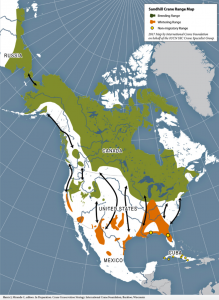
Source: International Crane Foundation.
Alaska Range Map

Source: Alaska Department of Fish and Game.
Bird Biology:
Characteristics: Cranes are large, wading birds with long necks and legs, and a characteristic feathered tail bonnet, red crown, and long menacing beak. Their legs are black, and their plumage varies from shades of grey, brown, and rust. Juveniles have cinnamon-brown feathers and lack the red crown.
Lesser Sandhill Cranes typically weigh around 7.5 lbs and reach a shoulder height of 34-48 inches. Males and females are generally indistinguishable; here’s a tip: when giving an alert call or territorial call the males bring their head back 90 degrees (beak straight up in the air), while the female brings her head back only about 45 degrees (See photo below).
Lesser Sandhill Cranes have an impressive wingspan of 6-8 feet. When spotted flying overhead, look for slow rolling downbeats, and quick upbeats of those large wings. You can generally tell when cranes are ready to fly as they may show agitation, ‘crane’ their neck, and then take a few steps prior to taking off.
In the wild, a crane that survives the first year, generally has a life span of around 20-30 years. Cranes do not begin breeding until around four years of age.
Cranes use an iron oxide mud to paint their feathers. Painting, is believed to help camouflage the cranes from predators especially while the crane is on the nest. The crane will take a bundle of grass and dip it in the mud and then apply the mud to its feathers.
Preferred Habitat: Cranes inhabit a variety of open wetland and upland habitats for nesting and loafing. For roosting, cranes seek out wet areas or islands, which are safer from predators.
Crane Display: Cranes have a variety of display postures to signal different activities, including:
And, how we enjoy watching cranes dance, especially during courtships as they jump and hop while spreading their wings, with an animated bowing to another crane – often like mirror images.
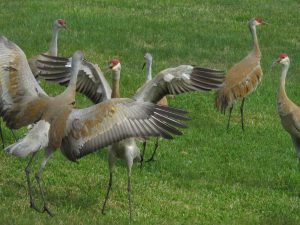
Want to learn more about Sandhill Crane displays? Check out the Sandhill Crane Display Dictionary: What Cranes Say with Their Body Language, by Yunker Happ. Go to: www.AlaskaSandhillCrane.com This field pamphlet is available at the Homer Bookstore, the Islands and Ocean Visitor Center, or Center for Alaskan Coastal Studies.
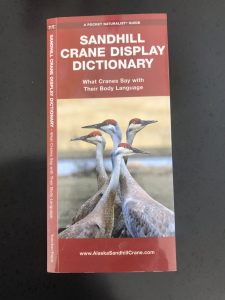
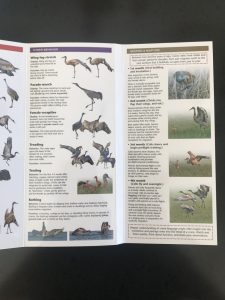
Reproduction: Cranes form pair bonds and mate for life (divorce does happen and a crane that loses a mate will bond again). Breeding begins around four years of age. They have low reproductive rates, in part, due to being long-lived birds.
Breeding Season: In the Homer area, the breeding season begins soon after the long-anticipated arrival of the cranes in late April/early May.
Nesting: The nest is nothing fancy, the main criteria is camouflage. Cranes are ground nesters, building simple nests of dry grasses and feathers, in the shape of a shallow depression.
The preferred nest site is an area protected from predators, with a preference for wetlands and islands. However, cranes in the Homer area haven’t read the memo and are found nesting in upland areas as well. A three-year crane nesting survey of the Homer Area, from 2011-2013, found 30 known nesting pairs and the probability that more remote nests were never reported or found.
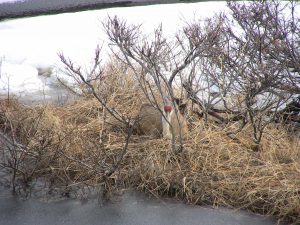
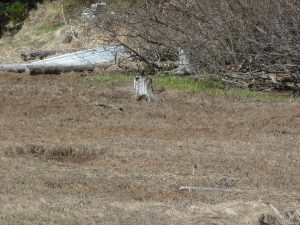
A master of camouflage – look carefully above the piece of wood on the lower right side of the photo.
Eggs and Incubation: The female generally lays two eggs, and if a crane pair experiences nest disturbance/abandonment early in the incubation period, they may nest again and lay additional eggs. Chicks hatch within 30 days.
Both parents incubate the eggs, however, the male’s primary task is to maintain the integrity of the territory. Incubating pairs trade places about every two hours during daylight hours. This gives each bird a chance to stretch, exercise, and feed. At night, the female incubates while the male stands guard. The male is often the first to feed the chicks.
The photos below show various crane nests; one with an egg; one with egg shell fragments (all photos by Michelle Michaud).
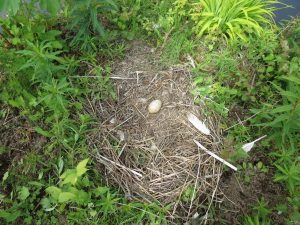

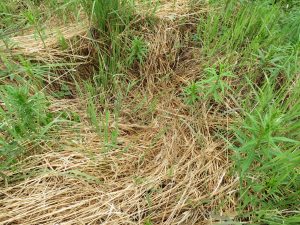
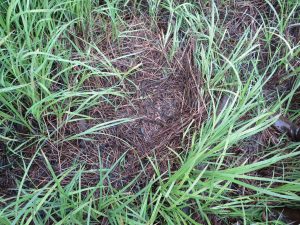

Nesting success is often dependent on habitat selection. Egg loss can be due to abandonment, or predation (eagles, ravens, crows, gulls, dogs, coyotes, and lynx), or being stepped on by moose.
Prior to fledging, the colt is flightless and very susceptible to predation. Colt loss can be due to a number of factors: predation, especially by eagles and dogs, lack of food, or parental neglect; or exceptionally bad weather, like wind and rain or snow in early spring. Photos by Nina Faust.
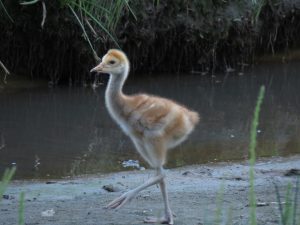
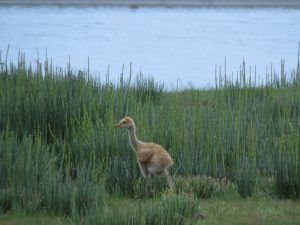
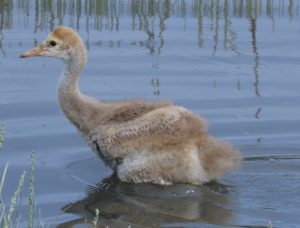
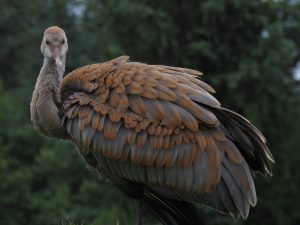

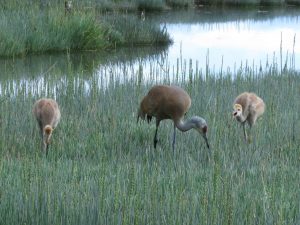
Fledging: Colts fledge within 60-70 days. They stay with their parents for 9-10 months. When the parents return to the breeding grounds, the adults chase off the colts to start a new family. These colts have now gained the red coloring on their heads, as well as the yellow eyes of an adult, and will join a group of non-breeding subadults — the crane equivalent of a roaming band of juveniles.
Not all crane colts survive to fledging. In Homer in 2017, 29 known breeding pairs produced 54 colts, of which only 34 colts fledged.
Food Preferences: Cranes are omnivores – eating frogs, voles, shrews, insects, bulbs, seeds, berries, and even baby ducklings.
Homer cranes are habituated to humans, especially when fed whole or cracked corn. Such feeding, however, is not necessary. There is sufficient food available in the wild for the cranes to obtain the nutrients needed for growth and survival. Feeding Cranes in an urban setting can be detrimental to the crane as it exposes them to predators, especially dogs and eagles. The urban habitat often lacks good nesting sites and natural sources of protein necessary for chick development. Other urban hazards affecting crane mortality include collisions with electrical power lines and vehicles, attacks by roaming neighborhood dogs, and poisoning from pesticides used on lawns. Also cranes can become aggressive protecting their young and can injure pets or humans.
Roosting: Cranes roost in large flocks, generally in shallow bodies of water to avoid predation. Cranes with colts that have yet to fledge roost separately, generally near the nest site (within their breeding territory).
Population Estimate: According to Kachemak Crane Watch, the Sandhill Crane population in the Homer Area (Anchor Point south to Kachemak Bay) is stable at around 200-250 individuals recorded annually.
Migration: In 2008, a study sponsored by Kachemak Crane Watch and conducted by the International Crane Foundation, sought to discover the migration route and wintering grounds of Homer area Sandhill Cranes. Ten (10) cranes were captured and fitted with satellite and radio transmitters. The study revealed several key findings: migration route, where the cranes winter (Central Valley of California), amount of time needed to reach their breeding and wintering grounds, and where they stopped during migration to refuel (See Figure 1 below). The journey from Homer to the Central Valley of California is approximately 2,400 miles – one way! The cranes take approximately one month during the fall migration to reach the Central Valley of California and approximately two months during spring migration return to Homer. They may spend up to a week or more at a staging area along the route in order to “refuel” for the long journey.


Figure 1: Map showing the transmitter data of the migration route of the Homer area banded cranes, including the different staging areas where they spent some stop-over time en-route to their breeding and wintering grounds. You can find this figure at: http://cranewatch.org/wp-content/uploads/2015/02/annual_travels_sh_cranes_homer_map.pdf
Vocalizations: Sandhill Cranes have several calls, but the most distinctive is the unison call – a loud, resonant bugle.
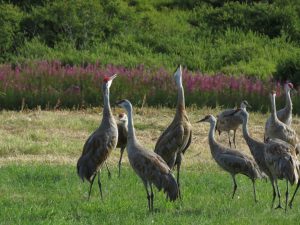
Listen now to the unison call
Threats: Habitat loss is a primary threat – loss of wetlands, grasslands and agricultural fields being developed, conflicts with agriculture, afforestation (trees taking over grasslands), conflicts with living in urban areas. Other threats include; drought, predation, impacts with vehicles, pesticide use on lawns and gardens, and collisions with power lines.
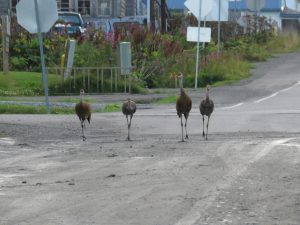
Hunting: Sandhill Cranes are hunted in Alaska for sport and subsistence, although they are protected under the Migratory Bird Treaty Act (MBTA). Hunting season begins in September, prior to migration. A number of other states also allow hunting of Sandhill Cranes, including Texas, New Mexico, and Arizona.
Fun Facts:
Conservation Status: The Sandhill Crane is a species of Least Concern, with populations generally increasing. Of concern is habitat loss and drought in California’s Central Valley, which significantly affects the Pacific Flyway population of Sandhill Cranes. The Pacific Flyway population is much smaller (approximately 20,000 birds) than the Central Flyway population (approximately 450,000 birds). The Central Flyway population are those cranes that make their way north through the Platte River in Nebraska.
In Homer, Kachemak Crane Watch (KCW) is dedicated to the protection of Sandhill Cranes and their habitat in the Kachemak Bay area.
The 2018 breeding season is fast approaching. Become a “Citizen Scientist”- KCW has been monitoring the Homer area crane population for over 15 years with the help of citizen scientists. With your help, KCW seeks information on:
Report your observations to Kachemak Crane Watch at 907-235-6262 or email report@ cranewatch.org.
Crane Species in Alaska: Only the Lesser Sandhill Crane subspecies is found in Alaska.
More Information:
For more information about Homer area Sandhill Cranes go to: www.cranewatch.org
For more information about all subspecies of Sandhill Cranes go to International Crane Foundation at: https://www.savingcranes.org/species-field-guide/sandhill-crane/.
Sources of Information:
Alaska Department of Fish and Game. Species Profile: Sandhill Crane. http://www.adfg.alaska.gov/index.cfm?adfg=sandhillcrane.main
All About Birds. 2017. Cornell Lab of Ornithology. https://www.allaboutbirds.org/guide/Sandhill_Crane/
Bailey, E. and Faust, N. 2017. Lesser Sandhill Cranes, Annual Summary. Homer, Alaska, Summer 2017. http://cranewatch.org/wp-content/uploads/2017/09/Annual-Summary-2017.pdf
International Crane Foundation. Sandhill Crane. 2018. https://www.savingcranes.org/species-field-guide/sandhill-crane/
International Union for Conservation of Nature. The IUCN Red List of Threatened Species. Version 2017-3. <www.iucnredlist.org>. Downloaded on 15 March 2018.
Sibley, David Allen. 2003. The Sibley Field Guide to Birds of Western North America. Andrew Stewart Publishing, Inc.
Todd, Frank S. 1994. 10,001 Titillating Tidbits of Avian Trivia. Ibis Publishing Company.
Yunker Happ, C. 2015. Sandhill Crane Display Dictionary: What Cranes Say with Their Body Language. Waterford Press.
This article is Part One of a two part serves on the different corvids found in the Homer Area. Part Two: Jays and Magpie will be featured in the Homer News in April.
For a link to the article in the Homer News go to: http://www.homernews.com/outdoor-features/2018-03-29/year-bird-meet-corvids-part-1-common-raven-and-northwestern-crow
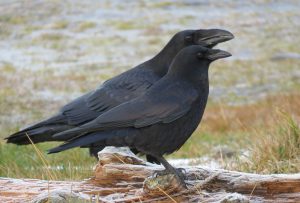
Throughout the year, the Homer News will be publishing articles on various bird-related topics as part of the 2018 Bird of the Year. A link we be provided here for each of those articles.
Gary Lyon talks about Downy Woodpeckers, Northern Saw-whet Owls, and Great Horned Owls. For more information on the Downy Woodpecker, check out our “Bird of the Month” page.
Bird Rhythms oiginally aired on KBBI on March 17, 2018 as part of the Kachemak Science monthly program.
Welcome to “Bird of the Month”. Each month we will be presenting a different bird species. We hope you enjoy it.
(Picoides pubescens)

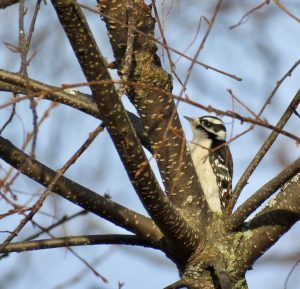
The Downy Woodpecker (Picoides pubescens) is the smallest North American woodpecker, weighing in at around 1.0 ounce (yes, that’s right – ounce), and only 6.75 inches in length. In comparison, the Hairy Woodpecker, which is most often confused with the Downy Woodpecker, and can also be found in the Homer Area, weighs in at around 2.3 to 2.5 ounces, and measures 9.25 inches in length. The Hairy Woodpecker has a longer, sharper bill, and lacks the black spots on the white outer tail feathers that are found on the Downy.
The Downy Woodpecker can be found and enjoyed in every state. In Homer, you want to search for the Downy Woodpecker in forested areas – after all, woodpeckers like trees, but remember, don’t ignore the small branches on bushes for the Downy.
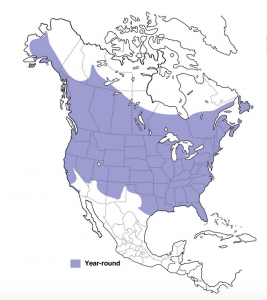
Source: Cornell Lab of Ornithology – https://www.allaboutbirds.org/guide/Downy_Woodpecker/maps-range
Bird Biology:
Characteristics: Both male and female of the species are black and white, however, the male is distinguished from the female with the presence of a red patch on the back of its head. Downy Woodpeckers pair-bond and are considered monogamous, however, during the non-breeding season, the pair may live alone.
Preferred Habitat: The habitat preferences of the Downy Woodpecker are less specialized than that of the Hairy Woodpecker. The Downy is generally found in open woodlands (especially deciduous trees – think Aspen and Birch – and brushy or weedy edges). They can also be frequently found in urban areas as a popular presence at a bird feeder or within city parks, backyards, and vacant wooded lots.
If you see a small black and white woodpecker on a low bush it is a Downy Woodpecker.
Breeding Season: The breeding season begins in early April in the southern United States and up to late May in the northern portion of its range – waiting for spring, just like us.
Nesting: Downy Woodpeckers are cavity nesters, utilizing a dead tree to excavate a cavity. The cavity is generally 8-12 inches deep and takes the pair 13-20 days to excavate.
Eggs and Incubation: Between 3-6 eggs are laid (although normally 4-5). Both pair will incubate the eggs, with the male assigned night duty. Incubation lasts around 12 days. The pair will typically fledge one brood per year.
Fledging: Both parents feed the young, with the young fledging within 20-22 days. Even following fledgling, the young depend upon their parents for up to three additional weeks for food.
Food Preferences: The Downy forages for insects, larva, and seeds. Have a Downy in your area and want a closer look, then put out a suet feeder and chances are a Downy will come to grace your feeder.
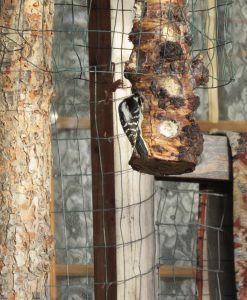
Feeding Methodology: The Downy feeds by an acrobatic ability to cling to tree trunks and branches, utilizing its specialized feet and tail feathers. The Downy can explore for insects along branches the size of twigs. Remember they only weigh an ounce.
The Downy works its way up a tree trunk in a series of rapid, jerky, stop-and-go movements. It can often be seen hanging upside down. The males tend to feed in the tops of trees on small diameter branches, while females feed midlevel or lower on large diameter branches.
Roosting: Downy Woodpeckers roost in tree cavities.
Migration: Downy Woodpeckers are permanent residents meaning they do not migrate, although there may be some movement in the winter with birds at higher elevations moving to lower elevations.
Want to see a Downy Woodpecker? Then you are in luck as the Downy Woodpecker can be found year-round in the Homer area.
Vocalizations:
Song: Sorry, no song. After all, Downy Woodpeckers are not Passerines, which are our songbirds. The Downy is a drummer.
Call: The call is a sharp “pik” sound. The call may vary in pitch and volume.
Drumming: While drumming is persistent, but there is a lag time of 10-15 seconds between drum sequences.
Even if the Downy doesn’t sing, who doesn’t get excited when hearing a woodpecker drumming and then anxiously looking for the source?
Fun Facts:
Conservation Status: The ‘Good News’ – the Downy Woodpecker is considered a species of Least Concern. The Downy Woodpecker is doing well in Alaska and does not appear on Audubon Alaska’s 2017 Watch List.
Woodpecker Species in Alaska: Other Woodpecker species found in the Homer area include the Hairy Woodpecker, American Three-toed Woodpecker, Black-backed Woodpecker, and the Northern Flicker. The last three, are uncommon to rare in the Homer area, but you may have been one of the fortunate birders to have seen the Three-toed and Black-backed Woodpeckers in the Homer area this past winter.
More Information: For more information about the Downy Woodpecker go to All About Birds (Cornell Lab of Ornithology) at: https://www.allaboutbirds.org/guide/Downy_Woodpecker/id/
Sources of Information:
All About Birds. 2017. Cornell Lab of Ornithology. https://www.allaboutbirds.org/guide/Downy_Woodpecker/id/
Baicich, Paul J. and Harrison, Colin J.O. 1997. Nests, Eggs, and Nestlings of North American Birds, 2nd Edition. Princeton Field Guides.
Dunne, Pete. 2006. Pete Dunne’s Essential Field Guide Companion: Comprehensive Resource for Identifying North American Birds. Houghton Mifflin Company.
Mayntz, Melissa. 2017. Collective Nouns to Describe Bird Flocks. 2017. https://www.thespruce.com/flock-names-of-groups-of-birds-386827
National Audubon Society. Edited by Elphick, C., Dunning, Jr. J.B., and Sibley, D.A. 2001. The Sibley Guide to Bird Life and Behavior. 2001. Alfred A. Knopf Inc.
Sibley, David Allen. 2003. The Sibley Field Guide to Birds of Western North America. Andrew Stewart Publishing Inc.
Todd, Frank S. 1994. 10,001 Titillating Tidbits of Avian Trivia. Ibis Publishing Company.
Warnock, N. 2017. The Alaska WatchList 2017. Audubon Alaska, Anchorage, AK 99501.
The Homer Christmas Bird Count, held on December 16, had 27 volunteers in the field in 11 teams to cover the traditions 15-mile diameter count circle centered in Mud Bay at the base of the Homer Spit. The weather cooperated quite nicely with temperature mostly above freezing and little wind. A total of 65 species were documented with 8,648 individual birds. Total numbers of several species were slightly lower in compassion to the last few years. The most abundant birds were Mallard (2,2251), followed by the Rock Sandpiper (1,250). Nine species only had one individual seen throughout the day.
Two species were new to the count: Costa’s Hummingbird and Black-backed Woodpecker. The hummingbird was seen approximately 5 miles out East End Road at a hummingbird feeder. The black-backed woodpecker was seen with an American three-toed woodpecker at the northern end of the Calvin and Coyle Nature Trail below Mariner Drive, approximately Mile 1 East Road. This woodpecker is normally found in interior Alaska and is generally rare along the coast. The Costa’s hummingbird, typically seen in southern California and Arizona, is well outside it’s normal range.
Species number and total numbers were generally within the normal range over the past several years. Numbers of wintering American Robins and Bohemian Waxwings continue to be relatively high with 121 and 254 individuals respectively. Counts for finches, including the Common Redpoll (328), Pine Siskin (1,011), Pine Grosbeak (316), were also relatively high in comparison to past years. However, the White-winged and Red Crossbills were totally absent from this year’s count.
Bald Eagle and Northwestern Crow numbers were slightly down this year in comparison to the last five years. The lack of available supplemental food at the Homer Transfer facility in recent years may have been a factor in this decline.”
A big thank you to all the many volunteers and to the staff at Islands and Ocean for letting us use their wonderful facility and helping us out also with logistics during the day. And to Dave Erikson for coordinating our Count here now for the last 41 years!